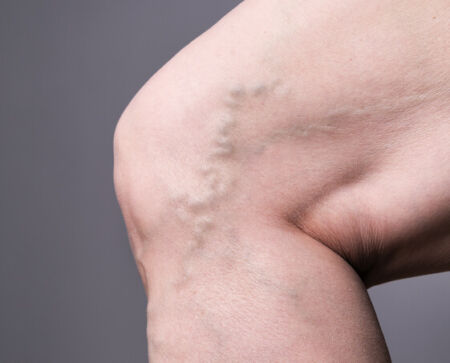
If you happen to be one of the millions of individuals in the U.S. who have varicose veins, you realize they can be more than a cosmetic issue. Varicose veins can cause pain, swelling, itching, tenderness in the legs, cramping, and blood clotting. In severe cases, varicose veins can result in discoloration of the skin, hardening of the tissues, and skin ulceration.
Treating varicose veins in their earlier stages, before progressive symptoms have time to become permanent, provides the best prognosis. Fortunately, many simple lifestyle changes can help manage these symptoms and even prevent new varicose veins from developing.
Standing or sitting for an extended period stifles regular blood flow through the veins of the legs. This reduced blood flow causes the pressure in the veins to increase, which can, in turn, create blood pooling around the ankles and swelling in the feet and calves. Eventually, varicose veins can appear. If your lifestyle or job doesn’t involve regular movement, consciously introduce periodic shifts in position and short walks into your day. You may also wish to introduce small exercises, such as pedaling your feet or stretching your ankles, to decrease venous pressure further and improve blood circulation.
Restrictive clothing creates a tourniquet effect that can reduce blood flow through the body. Swap tight, inflexible styles for looser, more comfortable clothes that support a greater range of motion and easier blood flow. High-heeled shoes should also be limited to special occasions rather than wearing them daily. Both your feet and your veins will thank you for those flat shoes.
A balanced diet is always advisable, but it can play an additional part in preventing or reducing the symptoms of varicose veins. Aim for a mix of protein, complex carbohydrates, and healthy fats. Avoid foods high in salt and processed sugar, which place stress on your vascular system and can exacerbate venous issues over time. Drink ample water over the course of the day to maintain proper hydration and blood circulation.
Smoking cigarettes significantly increases the risk of developing a variety of diseases, including venous disorders. Along with restricting circulation and narrowing the walls of the blood vessels, the chemicals in cigarettes can impede the flow of oxygen in the blood, make the blood thicker, and raise the risk of blood clotting. These changes contribute to varicose vein development and increase the likelihood of developing associated complications such as ulcers.
Like a healthy diet, regular exercise is part of a healthy lifestyle that can also play a role in varicose vein prevention. Exercise minimizes the risk of vein disease by strengthening the mechanism that returns blood from the lower body to the heart. If you are overweight, weight loss as a result of exercise improves circulation by relieving excess pressure on your veins.
Walking is a practical, low-impact activity that stimulates blood circulation while strengthening and stretching your calves. Elliptical machines, stationary bikes, swimming, and yoga also provide blood flow benefits with minimal stress on your joints. For a more vigorous workout, try jogging, running or weightlifting.
Compression socks and stockings place consistent, gentle pressure on the legs. This subtle squeeze helps veins and leg muscles move blood more efficiently to prevent varicose veins while reducing blood pooling, swelling, and pain caused by any current venous issues. Compression garments come in a range of strengths. Some are available by prescription only. Speak with your physician about which option will be most effective for you.
Even your off-hours can contribute to healthy veins. Elevate your legs when resting, sleeping, or engaging in relaxing activities like reading or watching television. Keeping your legs higher than heart level, even if only for a few minutes at a time, improves circulation and can help reduce leg swelling caused by a sedentary lifestyle.
Pregnancy is one of many factors that can exacerbate the risk of developing varicose veins. Hormonal changes during pregnancy can lead to increased progestin levels that dilate or open the vessels. Additionally, the uterus puts pressure on the inferior vena cava (the vein that carries blood from the lower body to the heart), further contributing to varicose veins. Sleep on your left side to keep pressure off this major vein, which is located on the right side of your body.
Not all varicose veins can be prevented. Some of the factors that may increase your risk for this condition, such as family history or age, are impossible to avoid despite leading an otherwise healthy lifestyle. The strategies above can be helpful in preventing varicose veins from forming. They can also aid in reducing the size and painfulness of existing varicose veins and improve their appearance.
Should you develop varicose veins that cannot be alleviated using more conservative methods, medical treatment may be advisable to improve the signs and symptoms of the condition. At Center for Vein Restoration, we treat patients with innovative techniques that improve aesthetics and vascular health without invasive surgery. These treatments may use injectable solutions, laser technology, or radiofrequency energy to address affected veins without general anesthesia. There is usually no downtime afterward, so you can return to your routine quickly.
Call Center for Vein Restoration at 240-965-3915 to schedule a consultation. With various minimally-invasive options, including preventative compression hose and sclerotherapy, you can rest assured Dr. Carabasi will tailor your treatment to your specific needs for optimal results.